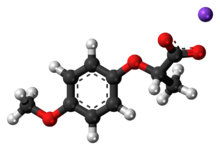Chemistry:Lactisole

| |

| |
| Names | |
|---|---|
| IUPAC name
Sodium 2-(4-methoxyphenoxy)propanoate
| |
| Other names
Lactisole; ORP 178; Propanoic acid, 2-(4-methoxyphenoxy), sodium salt
| |
| Identifiers | |
3D model (JSmol)
|
|
| ChemSpider | |
PubChem CID
|
|
| UNII | |
| |
| |
| Properties | |
| C10H11O4Na | |
| Molar mass | 218.188 g/mol |
| Appearance | white to pale cream, crystalline solid |
| Melting point | 190 °C (374 °F; 463 K) |
| Soluble in water and propylene glycol, slightly soluble in fat and miscible at room temperature in ethanol | |
Except where otherwise noted, data are given for materials in their standard state (at 25 °C [77 °F], 100 kPa). | |
| Infobox references | |
Lactisole is the sodium salt and commonly supplied form of 2-(4-methoxyphenoxy)propionic acid, a natural carboxylic acid found in roasted coffee beans. Like gymnemic acid, it has the property of masking sweet flavors and is used for this purpose in the food industry.[1]
Chemistry
Chemically, lactisole is a double ether of hydroquinone. Since it contains an asymmetric carbon atom the molecule is chiral, with the S enantiomer predominating in natural sources and being primarily responsible for the sweetness-masking effect. Commercial lactisole is a racemic mixture of the R and S forms.[2]
Natural occurrences
The parent acid of lactisole was discovered in 1989 in roasted Colombian arabica coffee beans in a concentration of 0.5 to 1.2 ppm.[3]
Anti-sweet properties
At concentrations of 100–150 parts per million in food, lactisole largely suppresses the ability to perceive sweet tastes, both from sugar and from artificial sweeteners such as aspartame. A 12% sucrose solution was perceived like a 4% sucrose solution when lactisole was added. However, it is significantly less efficient than gymnemic acid with acesulfame potassium, sucrose, glucose and sodium saccharin. Research found also that it has no effect on the perception of bitterness, sourness and saltiness.[1] According to a recent study, lactisole acts on a sweet taste receptor heteromer of the TAS1R3 sweet protein receptor in humans, but not on its rodent counterpart.[4]
As a food additive
The principal use of lactisole is in jellies, jams, and similar preserved fruit products containing large amounts of sugar. In these products, by suppressing sugar's sweetness, it allows fruit flavors to come through. In the United States , lactisole is designated as generally recognized as safe (GRAS) by the Flavor and Extract Manufacturers Association (Fema number: 3773) and approved for use in food as flavoring agent[5] up to 150 ppm. Currently, lactisole is manufactured and sold by Domino Sugar and its usage levels are between 50 and 150 ppm.[6] In the European Union lactisole is allowed to be used as a flavouring substance in foods, FL No. 16.041. [7]
See also
References
- ↑ Jump up to: 1.0 1.1 Kinghorn, A.D.; Compadre, C.M. (2001). Marcel Dekker. ed. Alternative Sweeteners (Third Edition, Revised and Expanded ed.). New York. ISBN 0-8247-0437-1.
- ↑ T. Nakagita et al "Structural insights into the differences among lactisole derivatives in inhibitory mechanisms against the human sweet taste receptor" PLoS One. 2019; 14(3): e0213552
- ↑ Ivon Flament; Yvonne Bessière-Thomas (2002). "The individual constituents". Coffee flavor chemistry. John Wiley and Sons. p. 207. ISBN 0-471-72038-0. https://archive.org/details/coffeeflavorchem00flam.
- ↑ Jiang, P.; Cui, M; Zhao, B; Liu, Z; Snyder, LA; Benard, LM; Osman, R; Margolskee, RF et al. (2005). "Lactisole Interacts with the Transmembrane Domains of Human T1R3 to Inhibit Sweet Taste". Journal of Biological Chemistry 280 (15): 15238–46. doi:10.1074/jbc.M414287200. PMID 15668251.
- ↑ JECFA "Specifications for Flavourings"
- ↑ Sugar sans sweetness - lactisole. Prepared Foods, May, 1995 by Fran LaBell
- ↑ 2002/113/EC: Commission Decision of 23 January 2002 amending Commission Decision 1999/217/EC as regards the register of flavouring substances used in or on foodstuffs
External links
- List of substances scheduled for evaluation or re-evaluation at the fifty-ninth meetingof the Joint FAO/WHO Expert Committee on Food Additives (JECFA). 2002
- EAFUS: A Food Additive Database
 |

